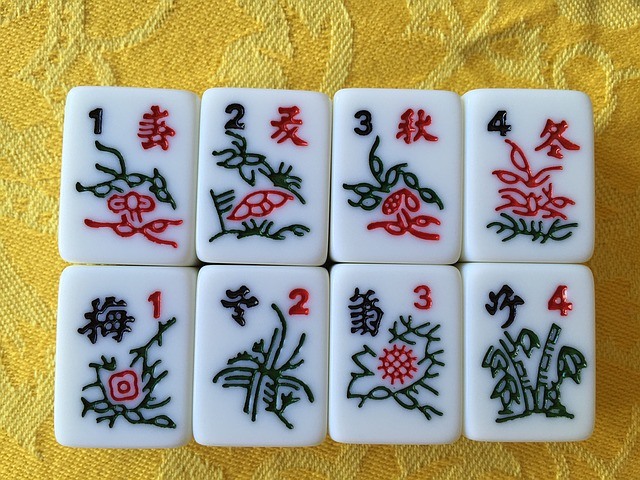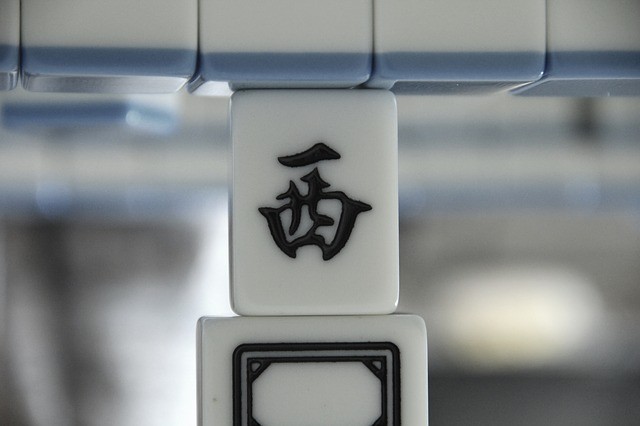Mahjong is one of the most popular Chinese games to date. After watching relatives or even numerous strangers on the street clacking tiles down and swiping them up, you may be wondering what all the fuss is about.
This short guide will provide a quick run-through of the standard rules in the game, its origins, and even explain how to make a mahjong set of your very own.
Contents
What is Mahjong?
Mahjong is a Chinese strategy game where players must be the first to gather four sets and one pair of tiles in what is known as a “mahjong.”
The pair must consist of two of the same tiles, while the four sets can consist of either “pung,” “kong,” or “chow.” Sets are also referred to as melds.
A “pung” is a set of three identical tiles in a row. A “kong” is a set of four identical tiles in a row. A “chow” is a string of three consecutive numbers all from the same suit (i.e. lining up a four-character tile, a five-character tile, and a six-character tile).
Typically, a “mahjong” is made by drawing and discarding tiles until someone gets a winning hand.
The game has continued to grow and evolve outside its home country of China, with different countries and even different regions within the same country presenting their own set of rules and special tiles.
But how did this game get to be so popular? When was this game created, and by whom?
Origins of Mahjong
Many people would attribute the invention of mahjong to Confucius, an extremely prolific Chinese philosopher whose teachings permeate all throughout present-day Chinese culture.
This is because the three sets of dragon tiles in the game have been likened to his three noble virtues—sincerity, familial piety, and benevolence.
He also had a strong affinity for birds, and because the name “Mah Jong” has the Chinese word for “sparrow” in it, many Chinese people today often associate the game with Confucius’ teachings.
However, a 2013 Stanford report finds that the mahjong of today actually originated near Shanghai in the mid-to-late 1880s.
By 1905, the number of players all around China had increased exponentially, and thus a standard set of rules for the game had to be established.
The rules for shuffling, how to construct the four walls from the tiles, dealing the tiles, and the creation of the “kong” set were developed around this time.
This more complex rule system was put into place mainly to ensure that no one could cheat during the game. At the time, mahjong was almost exclusively played among gamblers.
However, once American entrepreneurs and tourists became swept up in the mahjong craze in the 1920s, mahjong soon cemented itself as a game that connected other cultures together.
Mahjong’s popularity spread across the West, with many variations to the game already cropping up among all sorts of communities throughout America and Europe.
In particular, the Stanford study found that both Chinese-American and Jewish-American communities thrived from the widespread popularity of the game.
Chinese-Americans finally found a point of connection with both their cultural roots and with the wary white American populace that saw them as mere foreigners rather than neighbors.
Mahjong also brought together the Chinese-American community as a whole, where people of all ages, genders, and backgrounds could simply sit and play with one another based on shared heritage alone.
In the years following World War II, Jewish communities, and in particular, Jewish women, became quite fond of the game as well. The huge migration families made from crowded urban areas to quieter suburban areas imposed a sense of isolation among Jewish women of the time.
Mahjong then became a way for these women to connect with one another, thus building up new social networks made up exclusively of those who loved to play the game. The study finds that many of these women still play together to this day.
How to Play Mahjong
Since the game has been adapted and readapted several times over, rules may vary depending on the country, region, or even specific neighborhood you want to play in.

Some places will grant you special tiles, while others will even implement new rules altogether.
However, for the sake of simplicity, here are the standard Chinese rules of mahjong that you can play in any country.
A complete mahjong set has 144 tiles and two dice. Most sets will also come with four racks to hold your tiles, as well as tallying sticks for scoring purposes.
A Note About Tiles
The 144 mahjong tiles are further split into three suits, honor tiles, and bonus tiles.
Suits
There are 36 Circle tiles (also called Dot tiles) with four sets of nine tiles, numbered 1-9 for each set.
These tiles have circles imprinted onto them corresponding to their number. For example, the four 1-tiles will each have one circle imprinted on the tile, the four 2-tiles will each have two circles, and so on.
There are 36 Character tiles with four sets of nine tiles, with the Chinese characters for the numbers 1-9 imprinted on each set.
There are 36 Bamboo tiles with four sets of nine tiles, numbered 1-9 for each set. These tiles will have bamboo shoots on them corresponding to their number.
Honor Tiles
There are 16 Wind tiles with four sets of four tiles representing the North, East, South, and West Winds respectively. These are one type of honor tile.
There are 12 Dragon tiles with three sets of four tiles representing the Red Dragon (which is often indicated by a red character), four tiles representing the Green Dragon (which is often indicated by a green character), and four tiles representing the White Dragon.
(The White Dragon is depicted as either a blank tile or four tiles with the letter P imprinted on it, which stands for “Pai”, meaning white or pure in Chinese). These are the second type of honor tile.
Bonus Tiles
There are also four Flower tiles and four Seasonal tiles. Drawing any of these tiles will grant you bonus points.

While the depiction of the flowers on mahjong sets will vary depending on the set, the most common variations include plum blossom, orchid, chrysanthemum, and bamboo.
The four Seasonal tiles were later added to the game to aid those who could not read Chinese characters.
Mahjong Rules
Typically, mahjong is played with four people, though some Southeast Asian countries do have three-player variations as well.
Set-Up
First, have one person shuffle four wind tiles, face-down, and deal them out to each player. Players will then sit according to the wind placement they received, sitting clockwise around the table in the North, East, South, and West positions respectively.
Keep in mind that you do not have to actually position your table to face their respective cardinal directions. This seating arrangement simply determines who the dealer will be.
The dealer always sits in the East position of the table. Because the East is a key position, this seat scores double – but keep in mind that it also pays double as well. Many modern players will also simply roll the dice to determine a dealer.
Now the dealer must shuffle all the tiles together, face-down. Novice players should leave out the flower and season tiles, at least until they have a better grasp of the standard rules of mahjong.
Each player then takes 34 tiles, leaving them face-down, and arranges them into a wall of two stacks of 17 tiles each. These walls should then be pushed together to form a square.
The dealer then rolls the dice. Whatever number they land on, they must then separate that many tiles on the right side of their wall.
The rest of the wall is used to deal 13 tiles clockwise to each player, except for the dealer, who gets 14 tiles at the start.
Players then arrange the tiles in front of them, so that they can see their tiles but other players cannot. Using racks are helpful for keeping your hand hidden.
Here’s a video explaining more on how to play mahjong.
Gameplay
The dealer starts by discarding one of their tiles face-up in the center and drawing one from the wall. Any player can then choose to take that discarded tile to complete either a “pung,” “kong,” or “chow” meld – or even a straight mahjong from the tiles they already have.
You must call these melds out as you make them, flipping them face-up to the other players to reveal them.
The person who calls out a meld must then discard another tile not a part of that meld, and the turn will pass to the person on their right. If none of the discarded tiles complete a meld or pair for you, then you can draw a face-down tile from your wall.
In the case of a “kong,” a player can pick up an extra tile before discarding.
The game continues in this fashion until someone earns a winning hand or all the tiles have been used up. In the latter case, the game has ended in a draw, and the dealer must reshuffle the tiles.
However, even if someone earns a mahjong, they have only won for that round.
After that round is finished, the deal rotates to the right and that person becomes the dealer for that round.
The game officially ends once everyone has had the chance to deal twice. The winner is the one with the greatest number of points at the end of it all.
Point systems vary by region, so players should agree on which to go by prior to every game.
How to Make Your Own Mahjong Set
Admittedly, mahjong sets can be quite pricy. The cheapest sets you can find remain steadily in the $50 range, while the nicer sets are well over $100 on Amazon.
If you’d rather not shell out that much money for a new set, then you can easily make your own mahjong set with materials you can find in an office supply store.
While using paper cards instead of tiles may be frowned upon, it can be a great way for novice players to gain experience with the game.
You can steadily work up to using cardboard or even hand-carved wooden tiles that you paint yourself after you’ve grown used to the rules of the game.
Here is just one example of a mahjong enthusiast creating their own set out of wood and colored pencils.

Materials
- Blank tiles.
- Printer.
- Printer paper.
- Label or adhesive paper.
- Laminate.
- Utility knife.
Instructions
- First, you must purchase your tiles. You can use the backs of dominoes, blank plastic tiles, or even use custom-cut wooden tiles from a hardware store.
- Choose the patterns you want to use for your mahjong set. While traditional sets use circles, bamboo, Chinese characters, dragons, and other symbols, you can customize your set by using other symbols, if you wish.
- Scan the symbols or pictures you want to use and re-size them on your computer.
- Print a test sheet on some regular paper to see if they fit the tiles. If they do, you can then print each picture on label or adhesive paper. Make sure you adjust your printer settings accordingly.
- If your label or adhesive paper does not already have a laminate coating, put adhesive laminate over each design. This will keep your tiles smooth and protect your designs.
- Cut each design out with a utility knife. The corners of each piece should be cut at a 45-degree angle, so as to prevent them from sticking out on the tile.
- Stick your designs to your tiles carefully.
- Play some mahjong and enjoy!
This video shows an example of how mahjong tiles are made.
Conclusion
Mahjong is a huge phenomenon all over the world, and it is not hard to see why.
It has a rich history rooted in many nations, and it’s helped to shape friendships spanning many different cultures and backgrounds. Try out a game for yourself and see just how addictive this pastime can become!
Have you tried making your own Mahjong set?






